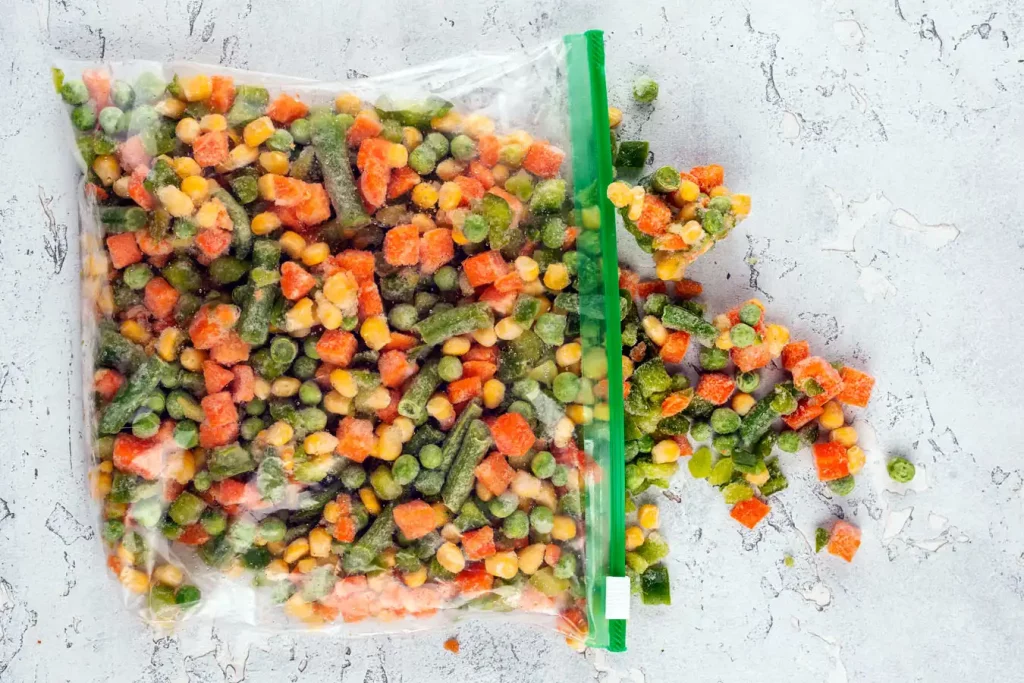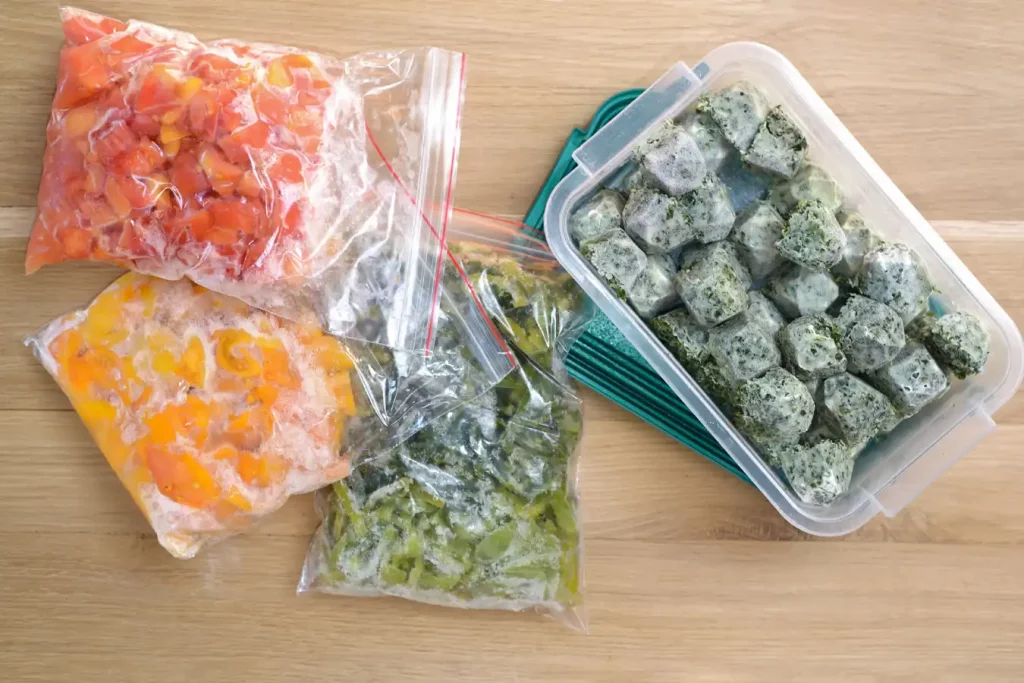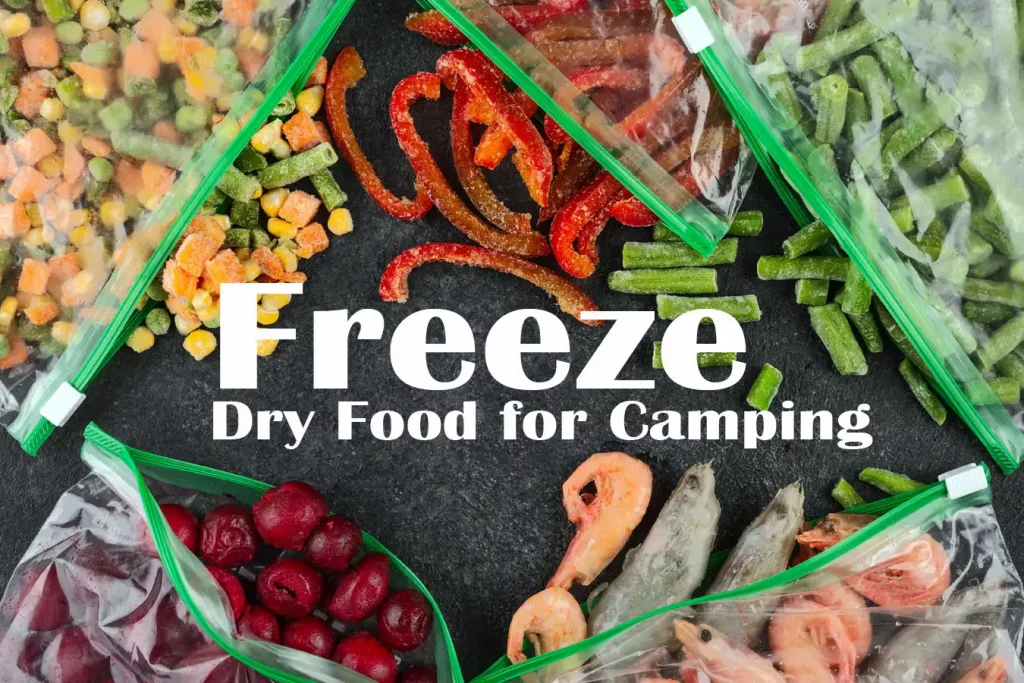Wondering how to freeze dry food for camping? You’re in the right place to get the best answer.
It’s about taking your favorite homemade meals and turning them into lightweight, trail-ready delights.
Join us as we explore the ins and outs of DIY freeze drying – no more settling for bland pre-packaged food on your next adventure!
What is Freeze Drying?
Freeze drying is a preservation process that removes water from perishable materials while maintaining its structural integrity and nutritional value.

The Science Behind Freeze Drying
In the process of freeze-drying, the water content in the food is reduced without having to pass through the liquid state, keeping the food’s structure intact. This technique is known as sublimation, and it’s the secret behind the success of freeze-drying.
When you’re in the great outdoors, and you open a pack of freeze-dried food, adding hot water will rehydrate it, and voilà! You’ve got yourself a meal that tastes just like it was freshly cooked.
Now, remember the science class in school where we learned about the states of matter? This is where it gets applied. The freeze-drying process cleverly utilizes the principle of sublimation, bypassing the liquid state during phase transition, which keeps the food’s texture and nutrition nearly unchanged.
Advantages of Freeze-Dried Food for Camping
While freeze-dried food may sound like something from a sci-fi movie, its advantages are firmly rooted in reality. Especially when you’re camping, freeze-dried food offers several benefits:
- Lightweight: Since most of the water is removed, freeze-dried food is significantly lighter, making it perfect for camping trips where every ounce matters.
- Long Shelf-Life: With proper packaging, freeze-dried food can last for many years without refrigeration, making it a great option for long trips or for emergency backup.
- Nutrition Retention: Freeze-drying preserves most of the nutrients, offering healthy meals in the wilderness.
- Easy Preparation: Simply add hot water, and your meal is ready in minutes – no campfire necessary, although we all know that’s half the fun!
Equipment Needed for Freeze Drying at Home
Venturing into the realm of home freeze drying? A worthy endeavor, indeed! Before you start, you need the right equipment. While a freeze dryer is the main tool, there are a few other necessary items for the process. Let’s check them out.
Overview of Freeze-Drying Machines
Freeze-drying machines, also known as lyophilizers, are the heart of the freeze-drying process. These appliances have three main components: a vacuum pump to reduce pressure, a freeze-drying chamber for the food, and a condenser to trap sublimated water.
While it’s true these machines can be a bit pricey, they’re a valuable investment for outdoor enthusiasts. They allow you to create your own freeze-dried food, which is both cost-effective in the long run and enables you to customize your meals to your taste.
When choosing a freeze-drying machine, consider its size, capacity, and quality. Brands like Harvest Right offer freeze dryers specifically designed for home use.
Other Necessary Tools and Materials
Apart from the freeze dryer, you’ll need some additional tools and materials:
- Kitchen scale: This is essential to measure the weight of food before and after drying to ensure the process is complete.
- Sealable bags or containers: These are crucial for storing the freeze-dried food and preserving its shelf life. Opt for oxygen-absorbing packets for longer storage.
- Trays or pans: You’ll need these for placing food in the freeze dryer.
- Sharp knife and cutting board: These tools will help in cutting and preparing the food for freeze-drying.
Selecting Suitable Foods for Freeze Drying
Choosing the right food to freeze dry is key to ensuring taste and nutritional value are preserved. Let’s see which foods are best suited for this process and which ones to avoid.
Best Types of Food to Freeze Dry for Camping
Almost any food can be freeze-dried, but some are particularly well-suited for camping:
- Fruits and Vegetables: From apples and berries to peas and carrots, these preserve well and rehydrate quickly.
- Meat: Cooked meat, poultry, and fish freeze dry excellently and rehydrate with hot water.
- Meals: From spaghetti bolognese to chili con carne, entire meals can be freeze-dried, giving you homely comfort food on the trail.
- Dairy: Cheese, yogurt, and even ice cream can be freeze-dried for a lightweight, tasty snack.
Foods to Avoid Freeze Drying
While many foods are suitable for freeze-drying, some don’t respond well to the process:
- High Sugar Foods: Foods with high sugar content can be challenging to freeze-dry as sugar acts as a natural preservative that hinders the process.
- High Fat Foods: Foods with a high-fat content don’t freeze dry well because fat doesn’t sublimate and can turn rancid over time.
- Raw Eggs and Some Raw Meats: Due to their texture and water content, these may not freeze dry well. It’s best to cook them first.
Remember, the key is to experiment and find what works best for your taste and dietary needs.
Step-by-Step Guide to Freeze Dry Food for Camping
Ever heard the saying, “knowledge is power?” The more you understand about the freeze-drying process, the more empowered you’ll be to make the best camping meals for your needs. Let’s dive into the steps involved in freeze-drying food at home.
Preparing Your Food for Freeze Drying
First things first, get your food ready for the freeze dryer. If you’re using fruits or vegetables, wash them thoroughly. Cut your food into small, uniform pieces to ensure it dries evenly. Cooked meals should be cooled before freeze drying. Don’t forget to weigh your food before drying to compare with its weight after the process.
Setting Up Your Freeze Dryer
Next, spread your prepared food onto the trays of your freeze dryer. Ensure that the food pieces aren’t touching each other so that air can circulate freely. Now, position the trays in your freeze dryer, close the door securely, and we’re ready for the next step.
The Freeze Drying Process
Here’s where the magic happens. Turn on your freeze dryer and set the temperature and time as per the manufacturer’s instructions. The machine first freezes the food, then reduces the pressure in the chamber, causing the water in the food to sublimate.

Testing and Storing Your Freeze-Dried Food
Once the process is complete, test a piece of food to make sure it’s thoroughly dried. It should be light, brittle, and moisture-free. Weigh the food again to compare it with its initial weight. For storage, place your freeze-dried food in airtight containers or sealable bags, ideally with an oxygen absorber. Keep them in a cool, dark place until you’re ready to pack them for camping.
Read more: How to Use Dry Ice for Camping
Using Freeze-Dried Foods While Camping
Now that you have your homemade freeze-dried food, how do you make the most of it while camping? This section will guide you on rehydrating your food and some meal ideas you can try out.
How to Rehydrate Your Freeze-Dried Foods
Rehydrating freeze-dried food is a straightforward process. You simply add warm water and wait for the food to absorb it, typically in 5 to 10 minutes. However, the amount of water and time needed can vary depending on the type of food, so a bit of trial and error may be necessary to get it just right.
Meal Ideas Using Freeze-Dried Ingredients
The beauty of freeze-dried food is its versatility. You can use it to prepare everything from a simple breakfast of freeze-dried fruit with granola to a gourmet dinner of pasta with freeze-dried veggies and meat. You can even make desserts like apple pie using freeze-dried apples.
Remember, the goal is to make your camping meals enjoyable, not just a survival necessity.
Best Practices and Safety Considerations
Knowing how to freeze dry food for camping is great, but understanding the best practices and safety considerations is what truly makes you a pro. Let’s explore some tips for long-term storage and important safety precautions to consider.
Tips for Long-Term Storage of Freeze-Dried Food
Once you’ve freeze-dried your food, proper storage is key to maintaining its quality. Here are some tips to consider:
- Packaging: Use vacuum-sealed bags or jars with oxygen absorbers. This prevents air and moisture from affecting your food.
- Environment: Store in a cool, dark, and dry place. High temperatures can reduce the shelf-life of your food.
- Check periodically: Check your stored food for signs of moisture or spoilage.
Remember, good storage can make your freeze-dried food last for years!
Important Safety Precautions in Freeze Drying and Storing Food
Safety first, they say, and they’re not wrong. Consider the following safety precautions:
- Follow machine guidelines: Each freeze dryer comes with specific instructions. Follow them to a tee to avoid mishaps.
- Check for completeness: Ensure that all food is completely freeze-dried before storing. Partially dried food can lead to bacterial growth.
- Handle with clean hands and tools: Always ensure your hands, tools, and surfaces are clean when handling freeze-dried food.
FAQs about Freeze Dry Food for Camping
Can You Freeze Dry Food Without a Machine?
How Long Does Freeze-Dried Camping Food Last?
Is Freeze-Dried Camping Food Good?
How Do You Make Freeze-Dried Food for Backpacking?
Conclusion
So there you have it! The art of freeze-drying food for camping has never been so accessible. From understanding what freeze drying is, selecting suitable foods, through the process itself, right up to using your freeze-dried food while camping – we’ve covered it all. Remember the best practices and safety precautions for an even more fruitful experience.
Freeze drying can be a game-changer for your camping adventures, providing you with meals that are lightweight, easy to pack, and tasty. Plus, there’s nothing quite like enjoying a meal you prepared yourself in the great outdoors.
So, why not give it a go? You may find that it opens up a whole new world of camping culinary adventures. Happy freeze drying, and even happier camping!
Read next: How to Make Biscuits While Camping


